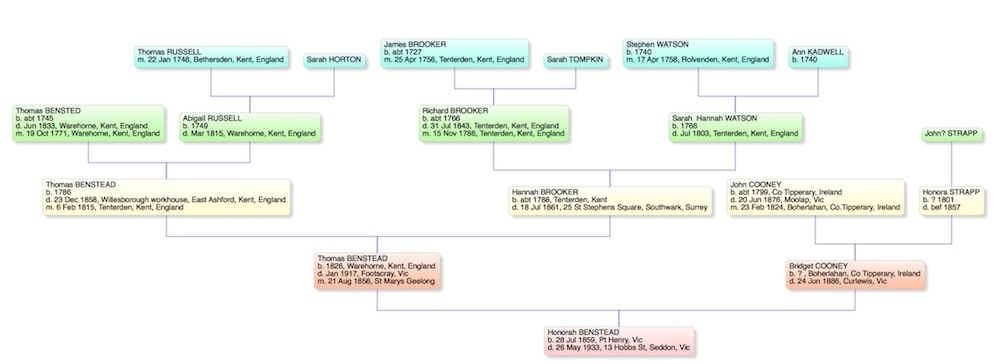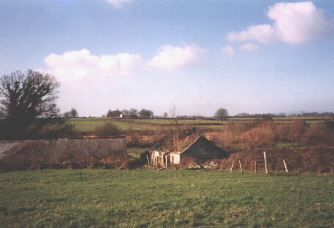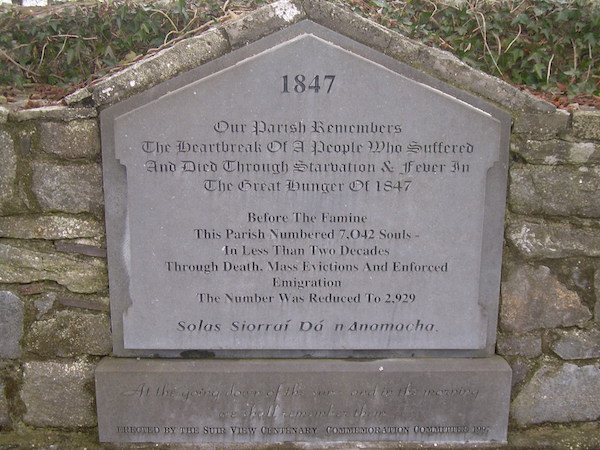
FOOTNOTES CHAPTER SIX
[1] From the Boherlahan register. Details were initially obtained through Winifred Pleydell of Elsternwick a great-grand-daughter of the couple, who in turn had obtained them from Fr Cody, a relative of Eileen Cody who married the William Strapp who witnessed the marriage. (Eileen and William were married in Boherlahan in 1815)
I was able to confirm the entry in the register when I visited Boherlahan in Dec 1988. At the time of my visit I was also put in touch with a Mrs Buckley whose great-grandmother was a Strapp. According to Mrs Buckley, there were only two families of Strapps in the district and they were both related which meant that we had to be related as well. She took me to the home of some other relatives nearby, who were still living on the original land owned by the Strapps. I was further informed that the two families had lived in separate houses on the property, one house was no longer standing, but the other was still in use as a storage shed. After hearing this I was taken across the rather soggy fields late at night in order "to put my hand on the wall of the family home". The following morning I was able to view the countryside in daylight and able to see first-hand the lush green countryside in this very beautiful and fertile region known as "the Golden Vale".
In 1996 I was able to revisit the area once again after making contact with a distant cousin, Tommy Strapp, who still lived in the townland of Mt Judkin near Cashel just a short distance from the land originally farmed by the Strapps. The father of Tommy Strapp was John Strapp (1880-1966) and his grandfather was Thomas Strapp. Although Tommy was not sure, he thought that the father of Thomas may have been named John who could therefore have been the brother of Honora who witnessed her marriage. The name Strapp is a very uncommon but Tommy put me in touch with a Finbarr O'Brien (then living at Tower near Blarney in County Cork) who was a descendant of a Jeremiah O'Brien and Ellen Strapp (b 1823) from Fethard in Co Tipperary. I was unable to establish a connection with the Strapps of Cashel but there is every likelihood they were related considering the rarity of the name and given that Fethard is not all that far from Cashel. Finbarr also had extensive knowledge of some other descendants of Jeremiah and Ellen who had emigrated to America (Ohio) and Canada.
Of the two Cody brothers and their sister who lived on the property at the time of my 1988 visit only Mick Cody survived and he was in the process of moving out to live with other nearby relatives. The farm had been sold and incorporated into a much larger one belonging to a Tim Hyde who was a breeder of horses.
I was able to inspect the ruins of an earlier house probably dating from the 19th century and where the father of Tommy Strapp had grown up. All of the walls were still standing, part of the roof had survived and there were even some old pieces of furniture and household utensils to be found inside. There was an adjoining barn in relatively good condition and next to the barn on its other side and directly opposite the house already described were the foundations of a much earlier house - most likely that in which Honorah Strapp would have lived early in the 19th century.
The size of the farm quoted in the text was provided to me by Tommy Strapp but I do not know whether it was at the time of Honora (which would have meant that the family was unusually well-off for that time) or later.
"
Ancestry of Honorah Benstead
[2] The following baptisms are recorded in the Cashel register (names of sponsors are shown in brackets):-
Bridget, March 21st 1827, (Thomas Dwyer, Mary Doherty);
Patrick, June 10th 1829 (Michael Carroll, Mary Cusack);
Honora, April 11th 1833, (John Cooney, Ann Cusack);
Judy, Feb 8th 1836, (John Lonergan, Honora Dwyer);
Margaret, May 23rd 1840, (Michael Carroll, Catherine Cooney) and
Thomas, Oct 13th 1844, (John Ryan, Jane Hewett).
In addition it is known that there were at least two other children (probably older):- Mary (Mrs Heaney) and Catherine (Mrs Hogan). Details initially supplied by Winifred Pleydell, a descendant of Patrick Cooney whilst the Cashel entries were confirmed on my visit in Dec 1988.

Entry in Cashel parish register for the baptism of Bridget Cooney
[3] From the letter of Fr Cody in the possession of Winifred Pleydell. The ruins of Hore Abbey are well preserved and lie beside the road that runs from Cashel to where the Strapps had their farm at Camus. In Gaelic the road was known as 'Bothar-een-na-mbocht' which means 'little road of the poor' a title that probably dates from the time of the famine and suggests that it was a route travelled by those either displaced or seeking some relief from the terrible conditions that existed at that time. (The word Bothr means road, hence Boherlahan which means 'broad road'). Mt Judkin took its name from an infamous judge who lived in the district at one time.

Site of the Strapp farm near Cashel in Co Tipperary. The roof of the barn is on the left and the ruins of the farmhouse are in the centre of the picture. The River Suir is at the bottom of the valley beyond the house.
[4] All information provided by Tommy Strapp and Finbarr O'Brien except for the theory re the Strapp-O'Meara connection which was published in "Family Names of the Island of Newfoundland" by E R Seary. Pat Murphy a descendant of the Strapps of Newfoundland, Canada contacted me in regard to the Strappe-O'Meara theory to say that he was aware of the claim published in the book referred to but believed that it was based on an error. Pat cited other older family members who had also expressed scepticism in regard to the theory and pointed out that the name did occur in England well before 1798.
"Old Joe" was owned by A J Douglas, trained by George Mulcaster and ridden by Tommy Skelton when he won the Grand National at Aintree in 1886. He started at the odds of 25/1.
[5] I
visited a family of Cooneys who lived on the main Cashel to Cork road
just south of Cashel. Although they did not have any knowledge of a
Cooney-Strapp connection they did say that there were many families of
Cooneys who lived in the area who they believed had emigrated to
America at the time of the famine. They said that it was possible some
had also gone to Australia and that John was one of those. Given
that John was unlikely to either read or write it is not surprising that he
would have lost contact with any family members who remained in Ireland
or who went to America.
Ardmayle is very close to Boherlahan. As the plaque suggests there was a very high death rate as a result of the famine and fever in the 1840's, which may may have included Honora. Even if she died from other causes the sheer volume of deaths may have created difficulty in maintaining records.

Famine memorial in Ardmayle graveyard
[6] Shipping records PRO Melbourne.
[7] Shipping records at PRO Melbourne. The age given here conflicts with the Boherlahan records, but she is the most likely candidate to be the daughter of John and Honora Cooney from the list of assisted passengers for reasons that should become clear in the narrative and which are explained in footnote [8].
[8] Shipping records at PRO Melbourne. The words quoted are not actually beside the entry for Bridget Cooney, but are written beside the previous entry with ditto marks entered underneath for Bridget. The previous entry is for a Mary Cooney from Co. Clare, aged 22, Catholic and able to read only. If Bridget and Mary had the same cousin viz. John O'Brien then they were perhaps cousins as well, although cousin is a fairly loose term. Bridget and Mary could possibly be sisters with Mary having previously moved from home, although it was believed that she was older than Bridget and also married in Ireland.
Also on board was Fanny Cooney of Co.Tipperary, 19, Catholic and able to both read and write. Upon arrival in Geelong, Fanny was employed by Mrs Rodien of Bellarine St, at 25 pounds, with rations, for three months. On board as well was Mary Cooney from Co.Tipperary, aged 25, Catholic and unable to read or write, who was employed by Mrs Wood of Bond St, Chilwell at the same rates as Fanny. Possibly some or all of these were related but in the absence of further information the precise relationship can only be a matter for speculation.
To really confuse the issue and open up other areas for further speculation, there were at least five other Bridget Cooneys who came to Victoria in the period 1853-55, four of them from Tipperary! As well there were many other Cooneys (mainly from Tipperary who arrived at this time.) In order of arrival the Bridget Cooneys were:- (i) Co.Tipperary, 27, Catholic, able to read only. Arrived in the "Bride" which sailed from Plymouth and reached Melbourne on May 17th 1853. She was accompanied by Margaret Cooney, 24, Catholic, able to read only and also from Tipperary. On arrival Bridget was employed by "S.Byrne, Cattleyards" - whatever that may mean, whilst Margaret was employed by Mr Johnson of 29 Swanson St. Whilst the age given for this Bridget agrees with the Cashel register it does not agree with the marriage records of St Marys Geelong, and if the Margaret accompanying her is her sister then she is too old to be the Margaret whose baptism is recorded in the Cashel register. (ii) A Bridget Cooney arrived in Melbourne aboard the "Omega" on Jan 17th 1854 after sailing from Plymouth three months before. She was 21, Catholic, from Co.Tipperary, and could read and write. However she seems to have been the wife of Patrick Cooney who was also aboard.
Of the remaining Bridget Cooneys, one was from Co.Clare and one was far too old to be the person of interest to this story, but aboard the "Parsee" which sailed from Plymouth and arrived in Melbourne on June 9th 1854, were two sisters from Co.Tipperary; both were Catholic, both were unable to read or write and both were domestic servants. Bridget was 19 - seemingly too young to be the Bridget we are interested in - whilst her sister Ellen was 18. The interesting point comes in the entry after each name in the column which details the employment taken up on arrival. For both girls the entry reads "gone with sister to Geelong, 14th June". Thus five days after arriving in Melbourne the sisters left for Geelong. could it have been to join relatives already in Geelong? the Bridget Cooney already in Geelong? or maybe the O'Brien's at Pt Henry just outside Geelong.
[9] Details from shipping records at Geelong Historical Records Centre.
[10] Death of John Cooney recorded in the 'Geelong Advertiser' of Thurs June 22nd 1876. The number of his grave is RC-2-90, however this does little to help locate it. All records for the Roman Catholic (RC) Section 2 were destroyed and there does not seem to be any pattern to the numbering of individual graves. Possibly John is buried in a plot which is known to contain a number of Cooney burials, including several of his grandchildren, although his name is not mentioned on any of the headstones.
[11] Margaret Haney is probably a relative of Bridget's brother-in-law William Heaney (Hainey) (all forms of spelling appear to have been used). It is recalled by Jack McFarlane (husband of Theresa) that until quite recently an area at Pt Henry was referred to as "Heaney's paddock". Patt Brien is probably one of the O'Briens of Pt Henry. Of the other children of John and Honora Cooney it is known that Mary, Honora (Annie), Catherine, Patrick and Thomas came to Australia, although as mentioned in the text they do not appear to have come out together. No trace has been found of the subsequent fate of the other children who probably died young in Ireland. The 1868 postal Directory of Victoria lists a Patrick Cooney, woodcarter, at Pt Henry.
Mary had at least 6 children and died at Leopold in 1916 at the age of 88 years. Patrick married Winifred Neligan in 1858 and fathered seven children. His death occurred at Leopold in 1917. Honora married Friedrich Wollars in 1868 and the couple had 6 children. At the registration of his children's births their father anglicized his name to Frederick Wallace. Honora died at South Melbourne in 1895. Catherine married John Hogan in 1860 by whom she had six children. She died at Melbourne West in 1917. Thomas married Bridget Flanagan in 1874 and the couple had ten children. He died at Richmond in 1900.
[12] Details from the marriage register of St Marys Geelong. Bridget's age given here is consistent with the shipping records but not with the Cashel registers. The information on her own death certificate is not quite consistent with any of the above. Probably she did not know her correct age (not uncommon at this time given that so many could neither read nor write). There does not appear to be any consistent spelling of the names "Bensted" (Benstead) or "Honorah" (Honora or Hanora or Nora) in the documents I have checked.
[13] From the marriage register at St Marys church, Geelong, and also from the marriage certificate of the couple.
GO TO CHAPTER SEVEN
RETURN TO CONTENTS PAGE